Biology of Big Brown Bat: Characteristics Related to Biology, Life Cycle, Appearance, Habitat, Diet, Behavior

As the name implies, the big brown bat is large in appearance, and it is also brown in color. This mammal is probably the biggest among other bats of the same species. It has large eyes and small thick ears. The other element about the appearance of a big brown bat is that it has short but broad wings. The fur is also long, and it is soft. Both female and male big brown bats are similar in appearance serve for the fact that a female one is slightly bigger than the male. Generally, it can be observed that a big brown bat appears big in different elements of its body.
Biology of the big Brown bat and Behavior
The diet of a big brown bat is varied. It feeds on a variety of flying insects particularly beetles and has strong teeth and jaws such that it can bite something that is very tough. The teeth of this mammal are dangerous, and this is the major reason why it is regarded as a predator. Just like other types of bats, the big brown bat moves at night. This is when it hunts for its prey, and its sight is also very good during this period compared to daytime. Interestingly, it is believed that a big brown bat uses the earth’s magnetic field to navigate back to its daytime resting place after a successful night hunting expedition. The other important biological aspect of the big brown bat is that during winter time, it hibernates and it is never seen flying until autumn period.
Life Cycle
Female species usually emerge in spring from hibernation when they prepare to give birth. The male bats will be staying alone during this period when the female is preparing to give birth, and these can only reunite in summer. However, the mating period of big brown bates is mainly autumn though they sometimes mate in spring or winter though fertilization takes place in spring. The female brown bat usually produces one or two babies, and these will be naked. Their eyes will also be closed only to open after about two days.
The big brown baby bats are capable of flying when they reach between three and five weeks. Before this period, the mother will be taking care of them and feeding them as well. Brown bats reach maturity in about three months, and the male ones are ready for sexual reproduction during their first autumn. However, females tend to be reproductive at the end of their first year. The big brown bats have a long life cycle since they can live up to 20 years in the jungle but some die during their first winter when the weather is biting.
Habitat of Big Brown Bats
The big brow bats live in different habitats. They adapt well in forests that are characterized by thick foliage. These species can also be found in both rural as well as urban areas. Usually, big brown bats prefer enclosed habitat like caves and they are also found in areas where people live. For instance, they prefer to stay in attics in different homes, and they can also choose to live in places like barns.
Read the How to get rid of bats page for helpful information and to learn more about Biology of Big Brown Bat: Characteristics Related to Biology, Life Cycle, Appearance, Habitat, Diet, Behavior
logy, Life Cycle, Appearance, Habitat, Diet, Behavior

